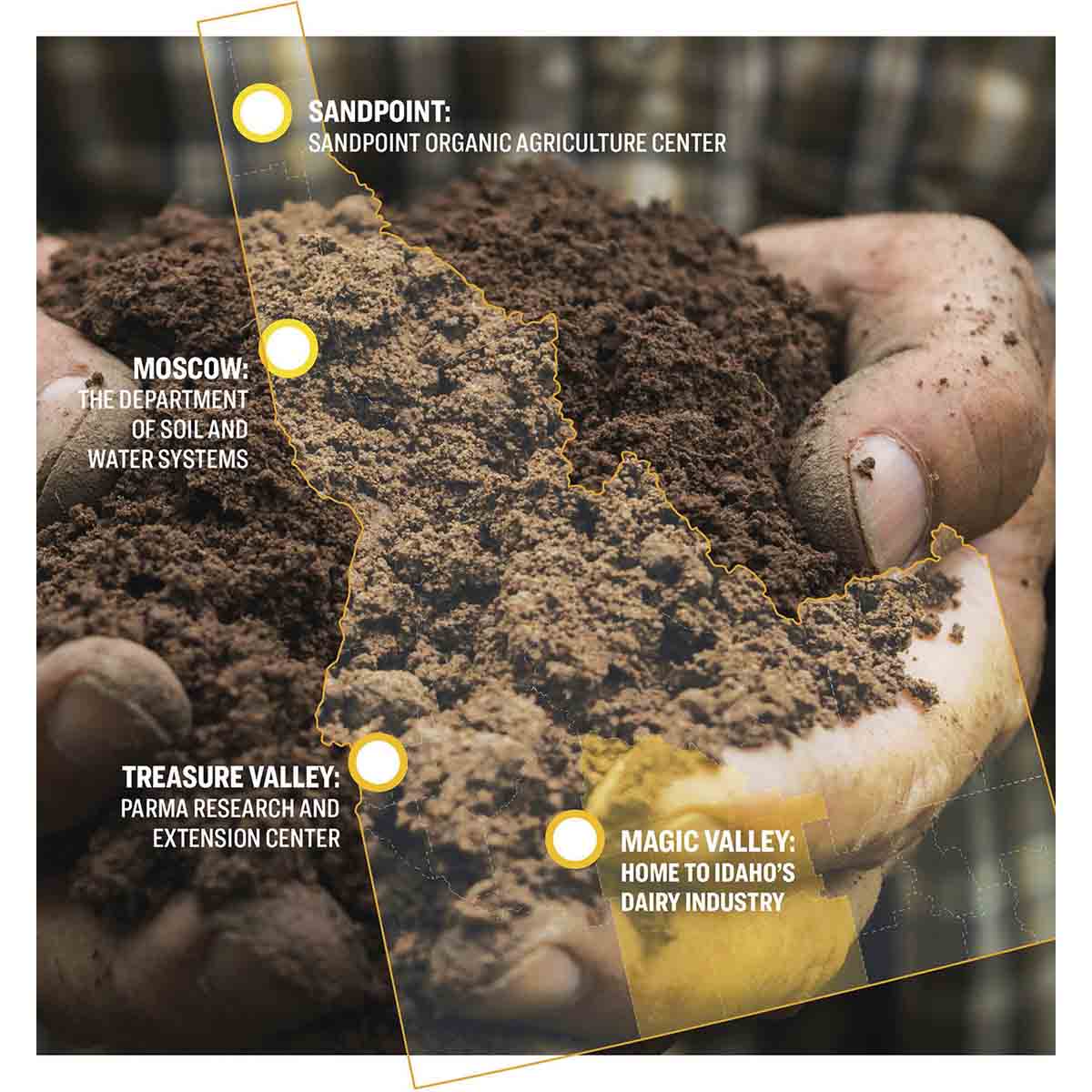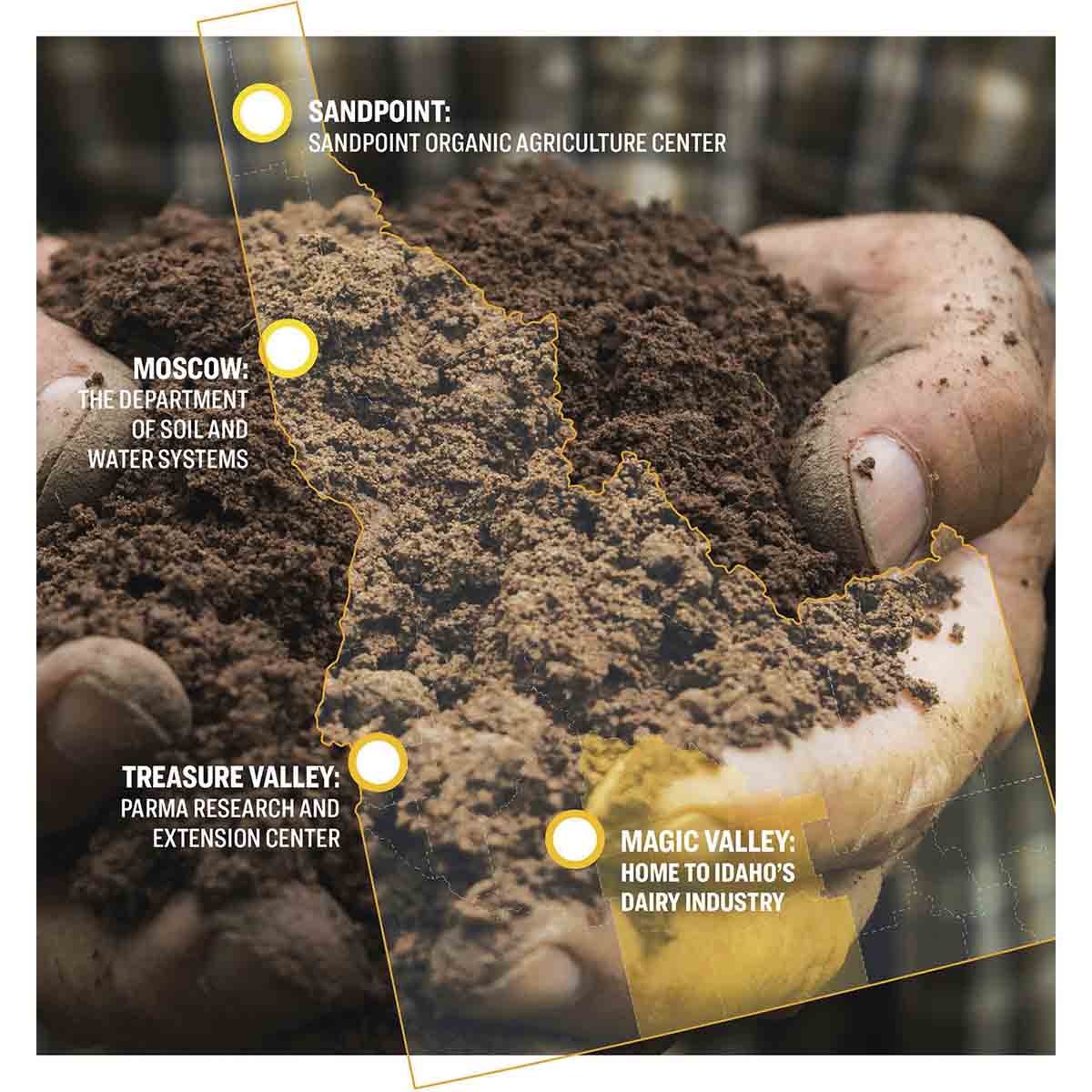The Hidden World Below
The world underneath our feet is sometimes described as science’s last frontier. In fact, scientists know more about the deep ocean than they do about what kinds of communities that reside and thrive in soil deeper than the topmost foot.
But one thing researchers know for certain is that healthy soil is essential to maintaining a safe and sustainable food supply for the world’s growing population.
Russ Zenner ’68, Palouse farmer and University of Idaho agricultural economics graduate, has been on a quest since the 1980s seeking production practices that prevent topsoil erosion on his cropland east of Genesee.
Zenner Farms is a case study on the dividends of soil-health investments. The farm is entirely no-till. Multi-species cover crops are planted and grazed by livestock, which introduces manure into the system. Sometimes multiple commercial crops are planted together, a process called intercropping. A third-party analysis confirmed these practices boosted soil carbon — which raises fertility, reduces erosion and improves the water-holding capacity of soil — by an average of a ton per acre.
“If we’re going to support a population that will have billions more people in the next few decades, we’ve got to figure out how to produce food with less inputs and less water, and we’ve got to take care of the topsoil,” Zenner said.
Estimates from the U.S. Department of Agriculture assert it takes more than 500 years for a single inch of topsoil to form.
U of I’s College of Agricultural and Life Sciences (CALS) is well-positioned to address these needs with a breadth of expertise in soil science.
“We have a long history of studying soil, soil quality and now soil health,” said Zachary Kayler, a U of I biogeochemist in the Department of Soil and Water Systems. “For years we’ve recognized if you don’t have healthy soil, you’re not going to have healthy crops, healthy businesses and healthy people.”
Kayler is a lead researcher on the forthcoming Deep Soil Ecotron, a cutting-edge laboratory that will study soil at greater depths than anywhere else in the world, made possible by a $19 million grant from the National Science Foundation. Researchers on the Moscow campus be able to control variables such as temperature, water and exposure to carbon dioxide and other greenhouse gases. It will contain 24 “eco-units,” comprising massive columns for studying core samples, below-ground organisms and above-ground plants.
The Deep Soil Ecotron is part of U of I’s increased focus on soil health which includes research statewide.
At the Sandpoint Organic Agriculture Center, scientists are in the final years of a project evaluating soil health in organic production systems, analyzing soils in vegetable beds and the surrounding orchard.
In Idaho’s Treasure Valley, scientists at the Parma Research and Extension Center are developing new methods of extracting DNA and RNA from soil pathogens, allowing farmers to detect viruses and other diseases affecting crops before they plant.
In the Magic Valley, home to Idaho’s dairy industry, scientists are sampling literal tons of soil to develop baseline data for future environmental research. This research will assess dairy’s impact on soil and water health at the U of I-led Idaho Center for Agriculture, Food and the Environment — the nation’s largest research dairy.
In October 2022, CALS scientists secured a five-year USDA grant for up to $55 million — the largest grant in university history to date — to implement and research which cropping systems are good for soils and resilient to changing climates. The project, titled Climate-Smart Commodities for Idaho: A Public-Private-Tribal Partnership, will incentivize the option for Idaho farmers and ranchers to adopt specified climate-smart practices like those already embraced by Zenner Farms, including cover crops, intercropping, composting and grazing cropland. The project will drive practices improving soil health on 10% of Idaho’s active cropland, preventing the emission of up to 100,000 tons of carbon dioxide per year into the atmosphere.
“Soil is critical to everything,” said CALS Dean Michael P. Parrella. “The bottom line is we are destroying soil and we are losing soil to erosion at a much faster clip than it is being created, but agriculture is poised to be part of the solution.”
To learn more about these projects, visit uidaho.edu/soil-science.

Article by John O’Connell, College of Agricultural and Life Sciences
Photos by University of Idaho Visual Productions
Published in the spring 2023 issue of Here We Have Idaho







